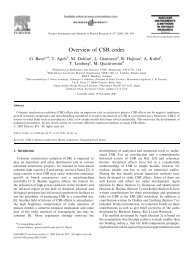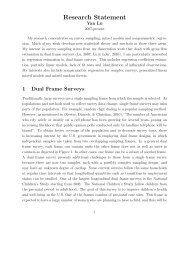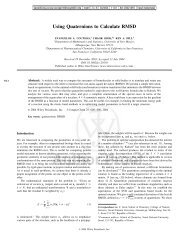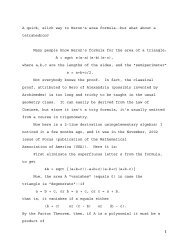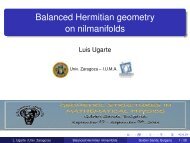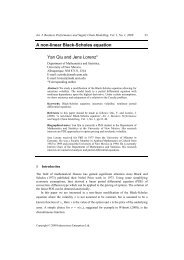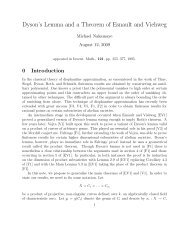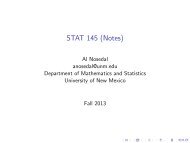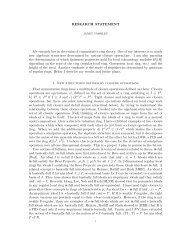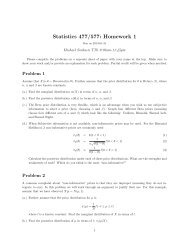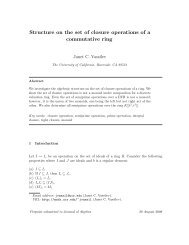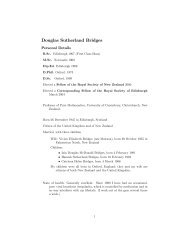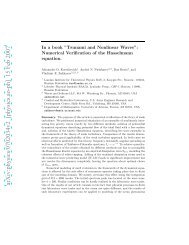OEO Office of Equal Opportunity - Department of Mathematics and ...
OEO Office of Equal Opportunity - Department of Mathematics and ...
OEO Office of Equal Opportunity - Department of Mathematics and ...
Create successful ePaper yourself
Turn your PDF publications into a flip-book with our unique Google optimized e-Paper software.
LINGUISTICS 239<br />
fulfill breadth requirements in any college. 101 <strong>and</strong> ANTH 110<br />
may not both be counted for credit.<br />
292. Introduction to Linguistic Analysis. (3)<br />
Basic concepts <strong>and</strong> technical vocabulary <strong>of</strong> language as a<br />
structured system: phonology, morphology, syntax, semantics.<br />
Emphasis on descriptive linguistics; some attention to<br />
language change <strong>and</strong> variation. Presumes no prior knowledge<br />
<strong>of</strong> linguistics.<br />
*407. Sanskrit I. (3)<br />
(Also <strong>of</strong>fered as MLNG, RELG 407.) An introduction to the<br />
Sanskrit language in conjunction with readings from classical<br />
Sanskrit literature in translation.<br />
*408. Sanskrit II. (3)<br />
(Also <strong>of</strong>fered as MLNG, RELG 408.) The continuation <strong>of</strong><br />
Sanskrit I: the completion <strong>of</strong> the study <strong>of</strong> Sanskrit grammar<br />
<strong>and</strong> an introduction to the reading <strong>of</strong> Sanskrit texts.<br />
295. Special Topics in Current Language Issues. (3 to a<br />
maximum <strong>of</strong> 12) ∆<br />
Special topics motivated by expertise <strong>of</strong> instructor <strong>and</strong> interest<br />
<strong>of</strong> students. Topics such as language <strong>and</strong> gender, language<br />
<strong>and</strong> politics, animal communication, language <strong>and</strong> aging <strong>and</strong><br />
languages <strong>of</strong> the world. May be repeated for credit as topic<br />
varies. {Offered upon dem<strong>and</strong>}<br />
303. English Phonetics. (3) Smith<br />
(Also <strong>of</strong>fered as CJ, SHS 303.) An introduction to the physiological<br />
mechanisms underlying speech production, linguistic<br />
classification <strong>and</strong> transcription <strong>of</strong> speech sounds, acoustic<br />
properties <strong>of</strong> speech sounds, relationship between phonetics<br />
<strong>and</strong> phonology, <strong>and</strong> applications to speech pathology.<br />
304./504. Phonological Analysis. (3) Smith<br />
(Also <strong>of</strong>fered as ANTH 317.) Phonetic principles <strong>and</strong> phonological<br />
theory, descriptive analysis <strong>of</strong> phonological systems, transcriptional<br />
practice, <strong>and</strong> problems from selected languages.<br />
Prerequisite: 303.<br />
412./512. Morphology. (3) Axelrod, Bybee<br />
An introduction to principles underlying structure <strong>of</strong> words<br />
<strong>and</strong> paradigms in languages <strong>of</strong> different types. How word<br />
structure reflects cognitive organization <strong>and</strong> how it is affected<br />
by child language acquisition <strong>and</strong> historical change.<br />
Prerequisite: 322.<br />
413./513. Linguistic Field Methods. (3) Axelrod, Gorbet<br />
(Also <strong>of</strong>fered as ANTH 413.) Practice in transcribing from<br />
oral dictation, phonemic analysis, introduction to problems<br />
<strong>of</strong> morphology.<br />
Prerequisites: 304 <strong>and</strong> 322. Restriction: permission <strong>of</strong> instructor.<br />
{Offered upon dem<strong>and</strong>.}<br />
415./515. Native American Languages. (3) Axelrod<br />
(Also <strong>of</strong>fered as ANTH 415.) Survey <strong>of</strong> Indian languages <strong>of</strong><br />
North America, with special emphasis on languages <strong>of</strong> New<br />
Mexico. Topics: linguistic structure in particular languages<br />
<strong>and</strong> language families; relationship <strong>of</strong> languages <strong>and</strong> cultures;<br />
<strong>and</strong> language loss, maintenance <strong>and</strong> preservation.<br />
ARTS AND<br />
SCIENCES<br />
322./522. Grammatical Analysis. (3) Axelrod, Gorbet<br />
(Also <strong>of</strong>fered as ANTH 318.) Principles <strong>of</strong> morphological <strong>and</strong><br />
syntactic analysis <strong>and</strong> introduction to functional <strong>and</strong> formal<br />
theories <strong>of</strong> grammar. Descriptive analysis <strong>of</strong> grammatical<br />
structures <strong>and</strong> problems from a variety <strong>of</strong> languages.<br />
Prerequisite: 292 or SIGN 305.<br />
331./531. Language in Society. (3) Axelrod<br />
Introduction to sociolinguistics. Topics: social dialects, societal<br />
multilingualism, language contact, language attitudes,<br />
language policy <strong>and</strong> planning, the role <strong>of</strong> language in binding<br />
<strong>and</strong> defining communities.<br />
Prerequisite: 101 or 292 or 440.<br />
334./534. Language <strong>and</strong> Gender. (3) Axelrod<br />
(Also <strong>of</strong>fered as WMST 334.) This course provides an<br />
introduction to linguistic analyses <strong>of</strong> language used by <strong>and</strong><br />
about women <strong>and</strong> men, exploring how language is used in<br />
constructing ourselves <strong>and</strong> others as men <strong>and</strong> women, gay,<br />
straight, or transgendered.<br />
359./559. Language <strong>and</strong> Culture. (3) Basso, Dinwoodie,<br />
Gorbet<br />
(Also <strong>of</strong>fered as ANTH 310 <strong>and</strong> CJ 319.) Examination <strong>of</strong> the<br />
interrelations <strong>of</strong> language <strong>and</strong> speech with other selected<br />
aspects <strong>of</strong> culture <strong>and</strong> cognition.<br />
Prerequisites: 101 or 292 or ANTH 110.<br />
367./567. Psychology <strong>of</strong> Language. (3) Morford<br />
(Also <strong>of</strong>fered as PSY 367.) Theoretical <strong>and</strong> methodological<br />
issues in psycholinguistics, including comprehension, speech<br />
perception <strong>and</strong> production, language acquisition, bilingualism,<br />
brain <strong>and</strong> language, reading.<br />
Prerequisite: 292 or PSY 265 or SIGN 305.<br />
*401–402. Topics: American Indian Languages. (3, 3 to<br />
a maximum <strong>of</strong> 12) ∆<br />
Introductory study <strong>of</strong> a Native American language, selected<br />
according to availability <strong>of</strong> instructor <strong>and</strong> student interest.<br />
May be repeated for credit as the topic varies.<br />
406./506. Introduction to Experimental Phonetics. (3)<br />
Smith<br />
Introduction to experimental methods used in the study <strong>of</strong><br />
speech. Laboratory exercises in computer-based measurement<br />
<strong>of</strong> acoustic <strong>and</strong> aerodynamic data. Acoustic theory<br />
illustrated by sounds in diverse languages. Introduction to<br />
speech technology.<br />
Prerequisite: 303.<br />
425./525. Semantic Analysis. (3) Axelrod, Cr<strong>of</strong>t, Travis<br />
An introduction to the study <strong>of</strong> sentence <strong>and</strong> word level<br />
meaning in the languages <strong>of</strong> the world, emphasizing the role<br />
<strong>of</strong> speaker <strong>and</strong> hearer, linguistic <strong>and</strong> extralinguistic context,<br />
lexical semantics, <strong>and</strong> grammatical meaning.<br />
Prerequisites: 292 or SIGN 305.<br />
429./529. Discourse Analysis. (3) Axelrod, Travis<br />
Introduction to the relationship <strong>of</strong> morphosyntax to the<br />
structure <strong>of</strong> discourse in the languages <strong>of</strong> the world. Topics:<br />
method <strong>and</strong> theory in the analysis <strong>of</strong> spoken <strong>and</strong> written discourse;<br />
basic notions such as topic, focus <strong>and</strong> cohesion.<br />
Prerequisite: 322.<br />
432./532. Spanish-English Bilingualism. (3)<br />
(Also <strong>of</strong>fered as LLSS 445.) An introduction to issues in<br />
bilingualism with emphasis on Spanish <strong>and</strong> English in the<br />
Southwest. Topics: language maintenance <strong>and</strong> shift, language<br />
policy <strong>and</strong> education, borrowing <strong>and</strong> codeswitching,<br />
first <strong>and</strong> second language acquisition, language attitudes.<br />
435./535. Societal Bilingualism. (3)<br />
Differential use <strong>of</strong> languages in multilingual societies; attitudinal<br />
correlates <strong>of</strong> use; language maintenance <strong>and</strong> shift in<br />
relation to other social change; language loyalty <strong>and</strong> group<br />
identification.<br />
Prerequisite: 331.<br />
436./536. Language <strong>and</strong> Education in Southwest Native<br />
American Communities. (3)<br />
(Also <strong>of</strong>fered as LLSS 460/560 <strong>and</strong> NAS *460.) This course<br />
explores the historical context <strong>of</strong> education <strong>and</strong> its impact<br />
on Native American communities <strong>of</strong> the Southwest. Topics<br />
include native language acquisition, bilingualism, language<br />
shift, <strong>and</strong> language revitalization efforts in native communities<br />
<strong>and</strong> schools.<br />
440./540. Introduction to Linguistics. (3) Axelrod<br />
Broad overview <strong>of</strong> the field <strong>of</strong> linguistics; principles <strong>and</strong> practices<br />
<strong>of</strong> linguistic analysis, sociolinguistics, psycholinguistics<br />
<strong>and</strong> educational linguistics. Oriented primarily to the needs <strong>of</strong><br />
present <strong>and</strong> prospective teachers.<br />
441./541. English Grammars. (3) Beene<br />
(Also <strong>of</strong>fered as ENGL 441.) A survey <strong>of</strong> various grammar<br />
models <strong>and</strong> their applications to analysis <strong>of</strong> the English<br />
language.<br />
Prerequisite: ENGL 240.<br />
UNM CATALOG 2006–2007 Symbols, page 611.



